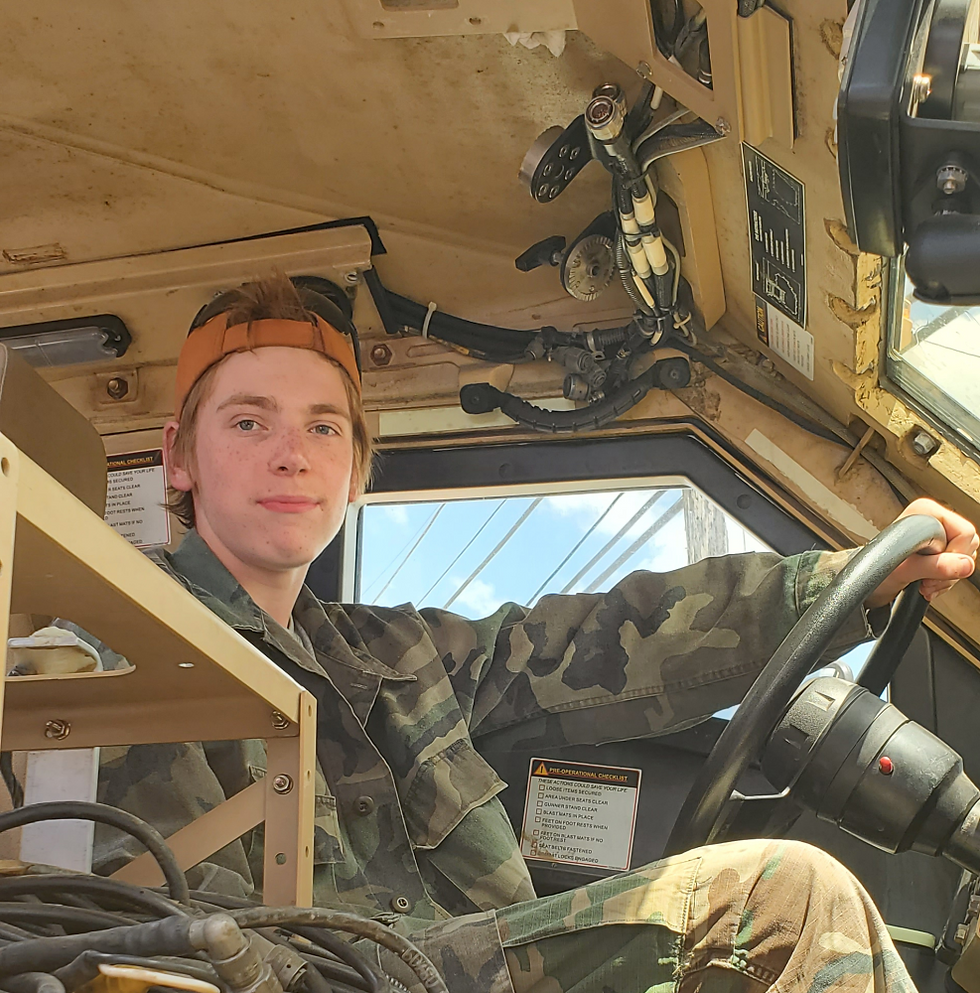The Challenges Baltimore and America Now Face
- EG Weiss

- Mar 27, 2024
- 8 min read

The footage of the Key Bridge collapse dominated the news channels for much of the day on March 26, 2024 with brief statements and interviews spattered throughout the afternoon. While the scene was horrific and certainly historic, nothing was more gut-wrenching than the announcement late the dame day that rescue operations had been halted and recover operations had begun.
The Key Bridge collapse was not a new thing in America, our infrastructure becomes fodder for conversation each time a tragedy like this interrupts our lives.
The main span of the 1932 original Eggner's Ferry Bridge in Kentucky collapsed after it was struck by the cargo vessel Delta Mariner on Jan. 26, 2012.
Eight towed barges collided with the Popp's Ferry Bridge near Biloxi, Mississippi, on March 20, 2009. A large span of the bridge collapsed into the bay.
On May 26, 2002, 14 people were killed after freight barges being moved by a towboat crashed into a pier of an Interstate 40 bridge over a reservoir near Webbers Fall, Oklahoma, collapsing about a third of the bridge.
On Sept. 15, 2001, four loaded barges struck a support of the Queen Isabella Causeway near Texas's South Padre Island, causing a partial collapse and killing eight people.
Loaded barges struck the Big Bayou Canot Bridge near Mobile, Alabama, on Sept. 22, 1993, displacing and deforming the rail's on the bridge. Minutes later, an Amtrak passenger train derailed and plunged into the water, killing 47 people and injuring 103 more.
The freighter MV Summit Venture hit a support pier of the Sunshine Skyway Bridge near St. Petersburg, Florida, during bad weather on May 9, 1980, plunging vehicles including a Greyhound bus into the Tampa Bay and killing 35 people.
A freighter hit the Sidney Lanier drawbridge near Brunswick, Georgia, on Nov. 7, 1972, collapsing it into the river below, killing 10 people.
The $25 trillion U.S. economy relies on a vast network of infrastructure to keep it afloat. But the systems currently in place, including roads, railways, electrical grids, and internet providers, were built decades ago and are struggling to keep pace. Economists say that delays and rising maintenance costs are holding economic performance back, and civil engineers warn that structurally deficient bridges and antiquated water infrastructure pose safety risks. Meanwhile, the United States lags behind other advanced economies in infrastructure quality and spending.
While monies appear to be dedicated to the bolstering of our crumbling infrastructure, politics and environment hold back a majority of the work to be done. In the meantime, we continue to suffer from procrastination and avoidance as well as the politicization of the projects themselves. This means that while we wait to see sufficient progress (which will not happen in my lifetime or yours due to the length of time it will take to complete even the simplest of projects) we will need to become more adept at handling each crisis while staying flexible enough to understand the insurmountable challenges we will face each time.
In the aftermath of the Key Bridge collapse in Baltimore, emergency responders are facing a myriad of challenges as they work tirelessly to assess the extent of the damage and ensure the safety and well-being of affected individuals. Specialists and experts have flown in from all over the country and (as I write this) are conducting critical infrastructure assessments and coordinating complex recovery operations. The response efforts have been multi-faceted and have required intense strategic planning and efficient execution in the waters now littered with the unstable debris from the collapse.
I want to delve into the key challenges that Baltimore responders have been encountering in the wake of the bridge collapse and explore the various aspects of their response efforts in overcoming these obstacles.
When the Key Bridge collapsed, one of the first challenges Baltimore responders faced was evaluating the extent of the damage. It was obvious to even those of us at home that was no small accident and the collapse was completely catastrophic. What was left of the bridge both above and below water required expert scrutiny to ensure the situation did not become worse. While responders were on the scene immediately, the air and water temperatures were of concern should there be any survivors in the water but determining which approach took precious time.
Response operations was an all hands-on deck for the search and rescue teams. These heroes needed to be deployed faster as instructors like myself wondered when the last exercise had been held that focused on such an event.
With a bridge now out of commission, traffic in Baltimore is about to go from bad to worse. Analyzing the flow of cars and figuring out alternative routes will be like trying to solve a giant puzzle that has pieces missing. It's a race against time to keep the city moving smoothly, or at least as smoothly as Baltimore traffic can ever be.
Implementing detours and traffic control measures will be similar to playing the role of traffic conductor in a chaotic symphony of honking horns and frustrated drivers; a delicate dance of redirecting cars without causing complete gridlock.
In times of crisis, teamwork makes the dream work. The coordination of local fire, police, and medical teams was essential for creating what was a relatively seamless emergency response. Collaboration is key as these different services work together like a well-oiled machine to handle the aftermath of the bridge collapse. Emergency transportation, increased accidents because of congested routes and frustrated drivers and severe weather will all become larger issues than before and is sure to last for some time as a new bridge cannot be erected overnight.
Effective communication and public information management are essential during any phase of the response to the Key Bridge collapse. Maintaining transparent and timely communication with the media and the public is crucial for providing accurate updates and instructions. When will the debris be removed? Will those contractor vehicles cause further traffic delays? What has the environmental impact been? At what point can the waterway be deemed safe for all water travel? Where is the scrap going and who is removing it?
Government officials and politicians alike will have to prepare for another line of questioning as well. That line involves the query: “What bridge is next?”
The truth is that it could be one of any 617,000 bridges across the United States. Currently, 42% of all bridges are at least 50 years old, and 46,154, or 7.5% of the nation’s bridges, are considered structurally deficient, meaning they are in “poor” condition. Unfortunately, 178 million trips are taken across these structurally deficient bridges every day. In recent years, though, as the average age of America’s bridges increases to 44 years, the number of structurally deficient bridges has continued to decline; however, the rate of improvements has slowed.
A recent estimate for the nation’s backlog of bridge repair needs is $125 billion. We need to increase spending on bridge rehabilitation from $14.4 billion annually to $22.7 billion annually, or by 58%, if we are to improve the condition. At the current rate of investment, it will take until 2071 to make all of the repairs that are currently necessary, and the additional deterioration over the next 50 years will become overwhelming with incidents like yesterday’s tragedy becoming becoming more commonplace.
I have for many years seen America’s infrastructure as one of the country’s biggest weaknesses. With an aging network of roads, bridges, and other critical elements, the country’s infrastructure has been struggling to keep up with the demands of a growing population and increasing technological advancements. The American Society of Civil Engineers gave the country’s infrastructure a dismal grade of 'D+' in their most recent report card, highlighting the severity of the situation. This low grade is due to a combination of factors, including outdated systems, lack of proper maintenance, and inadequate funding.
America’s roads and highways, which are vital for transportation and commerce, are crumbling under the weight of heavy traffic and insufficient maintenance. The water and sewage systems are also in poor condition, with an estimated 240,000 water main breaks occurring each year. In addition to the physical structures, the country’s digital infrastructure is also lacking. According to a study by the Information Technology and Innovation Foundation, the United States ranks 16th in the world for broadband access and speed. This not only affects individuals’ ability to access information and stay connected, but it also hinders the growth and competitiveness of American businesses.
Despite these glaring issues, the government has been slow to address them. The lack of political will and bipartisan cooperation has led to a stagnant approach to infrastructure improvements and could very well be the real cause of yesterday’s collapse. Yes, a large ship struck the bridge and that will most obviously be the cause in any report, but the reality is that our country has been torn apart from the inside out and cooperation is a key element in rectifying this scary situation.
While our infrastructural weaknesses leave us vulnerable to accidents like the Key Bridge, they are certainly known to our enemies who have undoubtedly already figured out that it takes very little to bring our country to its knees. As the second day of the Key Bridge comes to a close, conspiracies already abound as to whether or not this was a conscious act of terrorism or sabotage. It would certainly be a genius act to stop the flow of traffic in an area prior to a different style of attack. Was it just a ship out of control? A freak current? The point should be that if we do not begin to look at our infrastructure and begin to understand what a soft target we have become, we will certainly fall victim to the next act of aggression that is brought to our shores.
The consequences of a weak infrastructure are far-reaching and have a significant impact on the country’s economy, safety, and quality of life. It is imperative that urgent action is taken to address these issues and invest in the necessary upgrades, repairs and even security to strengthen America’s infrastructure for the future.
As I speak about the softness of our infrastructure, we must not forget America's other soft targets, such as schools, churches, and public gatherings, have unfortunately become easy targets for acts of violence, making it crucial to take steps to harden them. One way to do this is through increased security measures. This can include implementing stricter background checks for individuals purchasing firearms, as well as increasing the number of armed guards or police officers at these locations. In addition, conducting regular active shooter drills and training for staff members can help them prepare for potential threats and respond effectively in the event of an attack.
Another strategy to harden soft targets is by implementing physical barriers, such as bollards or reinforced doors, to prevent unauthorized access and make it more difficult for attackers to enter these spaces. Furthermore, utilizing technology, such as security cameras and metal detectors, can greatly enhance the security of these locations and provide early detection of potential threats. Moreover, promoting a culture of awareness and reporting suspicious behavior can also play a significant role in preventing attacks. This includes encouraging individuals to speak up if they see something concerning and providing a platform for them to report any potential threats.
By improving mental health resources and addressing social issues, such as bullying and isolation, we can help prevent individuals from resorting to violence in the first place.
Ultimately, hardening America's soft targets requires a multifaceted approach, including a combination of stricter security measures, technology, and promoting a culture of awareness and prevention. If a focused effort is directed at our crumbling infrastructure at the same time, we may be able to turn the ship before it strikes.




Comments